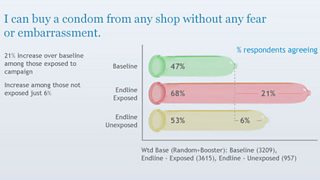Skating around social and behavioural change in the global response to HIV
Yvonne MacPherson
Executive Director, Βι¶ΉΤΌΕΔ Media Action USA
Waiting to cross the street outside the International Aids Conference in Washington DC last week, two teenage skateboarders noticed my branded conference bag and asked what it was all about. One asked about HIV testing, the other wanted to talk about how he could protect himself, confiding that he hasn't always used a condom.
Knowing that my conference goody bag included a pack, I asked if he wanted some and handed them over. As I crossed the street, I turned back and reminded them, "Don’t forget to use a condom every single time!"
Back at the conference, which was on its fifth and final day, I was struck by the lack of discussion about the role of awareness and behaviour change. With HIV having been around for decades and with most of the seriously affected countries having invested in information campaigns over the years, basic awareness seems to be taken for granted.
But is the job done? What about the next generations and tackling misinformation or denial about risky behaviour? Even in a country like the US, with universal education, and in the city with the highest prevalence of HIV in the country, this skateboarding duo had limited information.
So if the International AIDS Conference wasn't talking about awareness, what was the buzz? The biennial International AIDS Conference is usually dominated by announcements about progress in HIV science, such as advances in medicine to prevent mother to child transmission of HIV or improved drug therapies for treatment. This year, the big topics were treatment as prevention and voluntary male circumcision.
Treatment as prevention is a reference to treating an HIV positive person with anti-retroviral drugs that improve the health of the patient as well as reduce the probability of the virus transmitting to uninfected sexual partners (because treatment reduces the potency of the virus in the infected patient). Studies have also found that circumcised men have a reduced chance of infection than uncircumcised men.
Results from research published on the effectiveness of these two prevention methods offer new and diversified approaches to augment existing prevention efforts. These medicalised prevention solutions are particularly salient in countries where there is a generalised epidemic (where HIV prevalence is over 1% of the population) and in professional contexts (sex work) where risk levels are high.
But equally important to biomedical solutions is highlighting the importance of other major factors pertinent to the global response to HIV – social and behavioural influences on health and the significant role that information and communication can play in addressing these. In order for treatment as prevention to be a scaled prevention strategy, knowing one's HIV status is critical.
Globally, it is estimated that 33 million people are living with HIV, though only 25% are on treatment. Many people living with HIV do not know they are infected, which is one reason why UNAIDS estimates that 7 million people in low- and middle-income countries who are eligible for HIV treatment are not accessing it. It is important to get tested early, though many people are only tested once they have become ill.
It is not enough to address the supply side of testing alone – demand for testing needs to be tackled as well. Mass media campaigns can be effective at promoting testing and addressing the barriers to testing, such as ignorance and fear. For example, 20% of viewers of Βι¶ΉΤΌΕΔ Media Action's Indian TV reality show Haath se Haath Milaa (Let's Join Hands) said that they ever felt like getting tested for HIV compared to 11% of non-viewers.
Media and communications have been shown to be effective in addressing other influences on behaviour relevant to prevention. From 2007-2009, our reached 150 million men across India and helped change attitudes towards condoms across a range of criteria. Based on impact measurement data, embarrassment around purchasing condoms decreased and men were more likely to discuss and use them, compared to men who were not exposed to the campaign.

Although the International AIDS Conference is a good representation of the latest global thinking and approaches to HIV and AIDS, my hope now is for sustained investment in social and behaviour change programmes in addition to bio-medical solutions.
In light of exciting new developments in science, we cannot forget about people like the skateboarders on the streets of DC who lack basic information or the men in India who fear negative judgment from their community if they are seen to be purchasing condoms. What is needed is a mix of solutions to truly achieve UNAIDS’ vision of new HIV infections, discrimination and AIDS related deaths.
Related links
Elsewhere on Βι¶ΉΤΌΕΔ Media Action:
